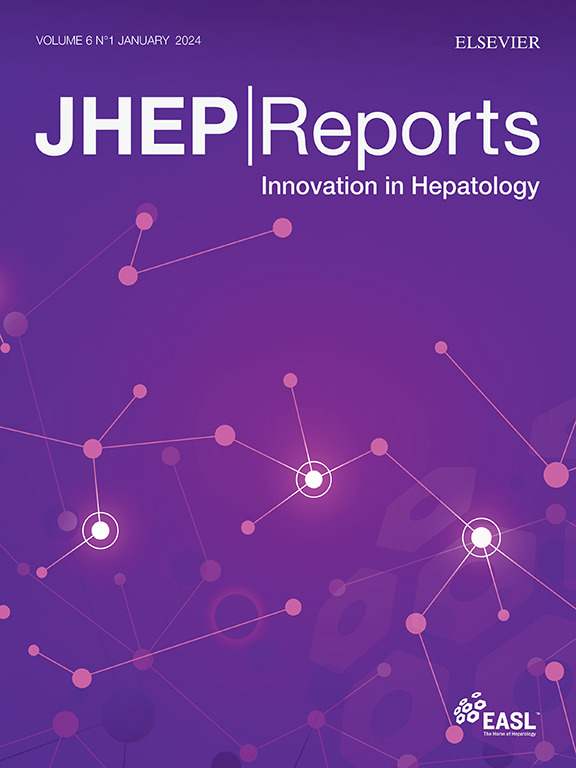特利加压素和奥曲肽在肝硬化和门静脉高压症患者中的血流动力学特征:一项随机、单盲临床试验
IF 9.5
1区 医学
Q1 GASTROENTEROLOGY & HEPATOLOGY
引用次数: 0
摘要
背景,目的:连续输注特利加压素可导致更持久的门静脉压力降低,且不良反应比一次性给药少。本研究旨在比较大剂量和特利加压素连续输注对肝脏和心肺血流动力学的影响和安全性。方法:本研究是一项单中心、单盲、双虚拟、平行组临床试验,38例肝硬化和门脉高压患者随机接受以下治疗:1 mg特利加压素+连续输注安慰剂(TERLBOL, n = 12), 1 mg安慰剂+连续输注特利加压素(如果在输注30分钟后肝静脉压梯度[HVPG]降低10%,则为2或4 mg/天)(TERLINF, n = 14),或1 mg奥曲肽(50 μg) +连续输注奥曲肽(50 μg/h) (OCTR, n = 12)作为另一个对照组。HVPG、心肺压和心输出量分别在基线、30min、60min和120min后测量。结果68%的患者为男性,中位年龄为59岁。两组的基线特征无显著差异。在TERLBOL组中,HVPG降低不显著(在120分钟,-4.9%;P = 0.14)。然而,心肺和平均动脉压显著升高,而心输出量和心率显著降低。在TERLINF组中,尽管30分钟后输注剂量加倍,但13/14例患者的心肺血流动力学或HVPG (NS)无显著变化。在OCTR组,HVPG无显著降低(在120分钟,-4.9%;P = 0.08),肺毛细血管压明显降低。所有治疗均耐受良好,无不良事件发生。结论三种治疗方法均无显著性降低HVPG。需要进一步的研究来确定持续输注特利加压素对肝硬化和门静脉高压症患者的最佳剂量策略。影响和意义:我们的研究结果没有显示门静脉压力的显著降低,至少在选择剂量后的前2小时是这样。虽然该研究不是在急性静脉曲张出血的情况下进行的,特利加压素被用作标准治疗,但这些结果并不支持单独输注特利加压素治疗急性静脉曲张出血的治疗策略,在这种情况下,快速降低门静脉压力被认为是控制静脉曲张出血的主要作用。值得强调的是,持续输注特利加压素方案耐受性更好,似乎具有更好的心肺安全性。其他持续输注特利加压素的治疗策略,如初始给药或更高的输注剂量,应进行评估,以支持其在静脉曲张出血治疗中的应用。临床试验编号:2019-004328-39。本文章由计算机程序翻译,如有差异,请以英文原文为准。

Hemodynamic profile of terlipressin and octreotide in patients with cirrhosis and portal hypertension: a randomized, single-blind clinical trial
Background & Aims
Continuous infusion of terlipressin may result in a more sustained reduction in portal pressure with fewer adverse effects than administered as a bolus. This study aimed to compare the hepatic and cardiopulmonary hemodynamic effects and safety profiles of bolus vs. terlipressin continuous infusion.
Methods
This is a single-center, single-blinded, double-dummy, parallel-group, clinical trial in which 38 patients with cirrhosis and portal hypertension were randomized to receive the following: 1 mg bolus of terlipressin + continuous infusion of placebo (TERLBOL, n = 12), a bolus of placebo + continuous infusion of terlipressin (2 or 4 mg/day if <10% reduction in hepatic venous pressure gradient [HVPG] at 30 min of infusion) (TERLINF, n = 14), or a bolus of octreotide (50 μg) + continuous infusion of octreotide (50 μg/h) (OCTR, n = 12) as an additional control group. HVPG, cardiopulmonary pressures, and cardiac output were measured at baseline and after 30, 60, and 120 min.
Results
Sixty-eight percent of patients were male, with a median age of 59 years. There were no significant differences in baseline characteristics. In the TERLBOL group, there was a nonsignificant reduction in HVPG (at 120 min, -4.9%; p = 0.14). However, cardiopulmonary and mean arterial pressures significantly increased, whereas cardiac output and heart rate significantly decreased. In the TERLINF group, there were nonsignificant changes in cardiopulmonary hemodynamics or HVPG (NS) despite doubling the infusion dose after 30 min in 13/14 patients. In the OCTR group, there was a nonsignificant reduction in HVPG (at 120 min, -4.9%; p = 0.08), and pulmonary capillary pressure significantly decreased. All treatments were well tolerated, and no adverse events were observed.
Conclusions
There were nonsignificant reductions in HVPG with the three therapeutic strategies. Further investigations are warranted to determine the optimal dosing strategy for continuous infusion of terlipressin in patients with cirrhosis and portal hypertension.
Impact and implications:
The results of our study do not show a significant reduction in portal pressure, at least in the first 2 h after the selected dose. Although the study was not performed in the setting of acute variceal bleeding and terlipressin was used as a standard therapy, these results do not support the treatment strategy of terlipressin infusion alone at the doses studied for the management of acute variceal bleeding, where a quick reduction in portal pressure is thought to play a major role controlling variceal bleeding. It is important to highlight that the continuously infused terlipressin regimen is better tolerated and appears to have a better cardiopulmonary safety profile. Other treatment strategies of continuous terlipressin infusion, such as initial bolus administration or higher infusion doses, should be evaluated to support its use in managing variceal bleeding.
Clinical trial identifier
EudraCT No. 2019-004328-39.
求助全文
通过发布文献求助,成功后即可免费获取论文全文。
去求助
来源期刊

JHEP Reports
GASTROENTEROLOGY & HEPATOLOGY-
CiteScore
12.40
自引率
2.40%
发文量
161
审稿时长
36 days
期刊介绍:
JHEP Reports is an open access journal that is affiliated with the European Association for the Study of the Liver (EASL). It serves as a companion journal to the highly respected Journal of Hepatology.
The primary objective of JHEP Reports is to publish original papers and reviews that contribute to the advancement of knowledge in the field of liver diseases. The journal covers a wide range of topics, including basic, translational, and clinical research. It also focuses on global issues in hepatology, with particular emphasis on areas such as clinical trials, novel diagnostics, precision medicine and therapeutics, cancer research, cellular and molecular studies, artificial intelligence, microbiome research, epidemiology, and cutting-edge technologies.
In summary, JHEP Reports is dedicated to promoting scientific discoveries and innovations in liver diseases through the publication of high-quality research papers and reviews covering various aspects of hepatology.
 求助内容:
求助内容: 应助结果提醒方式:
应助结果提醒方式:


